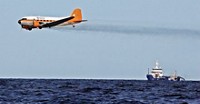Advertisement
Grab your lab coat. Let's get started
Welcome!
Welcome!
Create an account below to get 6 C&EN articles per month, receive newsletters and more - all free.
It seems this is your first time logging in online. Please enter the following information to continue.
As an ACS member you automatically get access to this site. All we need is few more details to create your reading experience.
Not you? Sign in with a different account.
Not you? Sign in with a different account.
ERROR 1
ERROR 1
ERROR 2
ERROR 2
ERROR 2
ERROR 2
ERROR 2
Password and Confirm password must match.
If you have an ACS member number, please enter it here so we can link this account to your membership. (optional)
ERROR 2
ACS values your privacy. By submitting your information, you are gaining access to C&EN and subscribing to our weekly newsletter. We use the information you provide to make your reading experience better, and we will never sell your data to third party members.
Environment
Seaweeds Have an Appetite for TNT
Algae safely remove explosive compound from coastal marine environments
by LOUISA DALTON
February 28, 2005
| A version of this story appeared in
Volume 83, Issue 9

ENVIRONMENTAL SCIENCE
Certain seaweeds can efficiently take up TNT in coastal areas, providing a new twist to phytoremediation--the practice of using plants to remove pollutants from the environment. The finding was reported last week at the American Association for the Advancement of Science annual meeting in Washington, D.C.
Some coastal training ranges may contain TNT from unexploded munitions, said Linda Chrisey, program officer for Environmental & Marine Biotechnology at the Office of Naval Research (ONR).
Seaweeds are excellent remediators, said Greg Rorrer, a chemical engineering professor at Oregon State University (OSU). He found that three types of seaweed actively remove TNT from the water in laboratory models. Red tropical algae take up 100% of 1.0 mg per L TNT in 72 hours. Red tropical, as well as green and red algae from temperate regions, take up TNT five to 10 times faster than other aquatic plants.
The seaweeds also metabolize TNT. Rorrer and graduate student Octavio Cruz-Uribe, along with Donald P. Cheney at Northeastern University, have shown that a nitroreductase within the algal cells reduces one of TNT's nitro groups to an amine. About 20% of the aminodinitrotoluene product is then released back into the water, and the rest is metabolized further, possibly to sugar conjugates, which are then sequestered in cell vacuoles.
What effect TNT might have on the coastal environment is unclear, Chrisey said. Nevertheless, ONR is keen to find ways to remove it and has funded the TNT research at OSU.
"It's very powerful to take a pollutant and convert it into something that is benign," Chrisey said.
Rorrer said he is now investigating how well seaweeds take up other marine pollutants, such as polyaromatic hydrocarbons.





Join the conversation
Contact the reporter
Submit a Letter to the Editor for publication
Engage with us on Twitter